#the way he experiments and recreate the way pixels/dots are rendered
Text

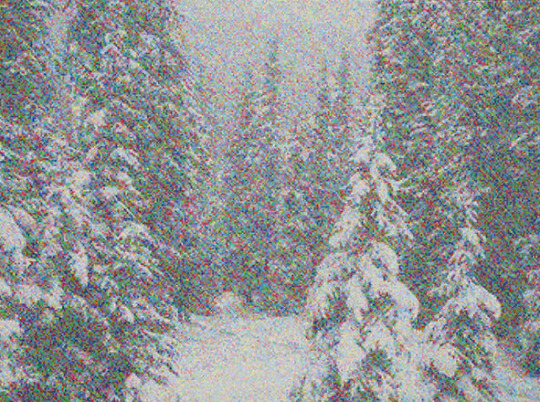

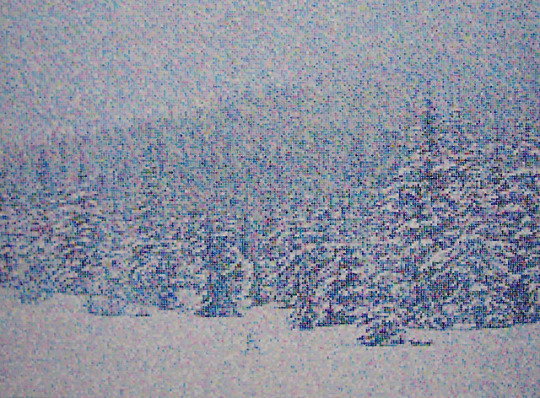


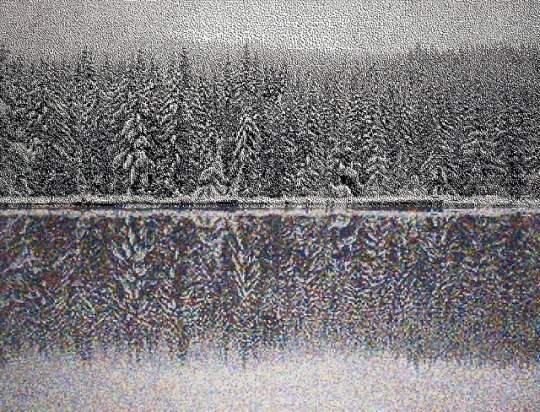
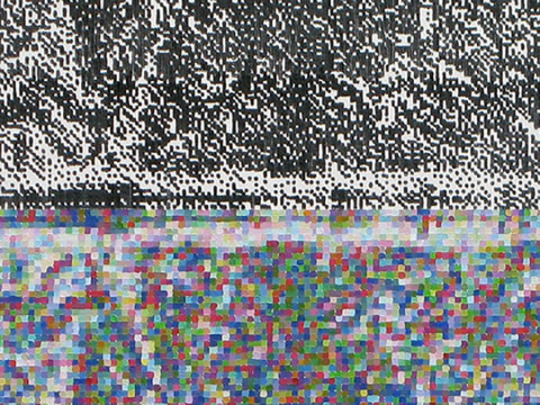
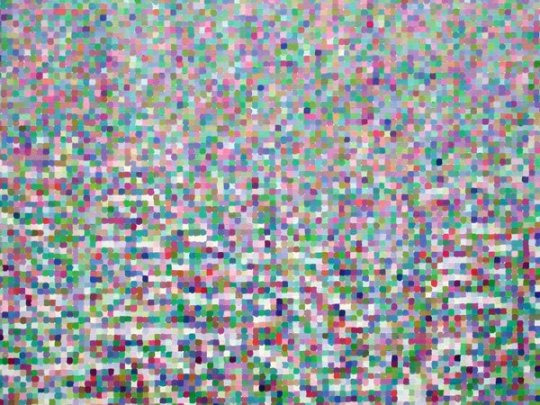

Dan Hays - Colorado Snow Effect (2008) - Oil on canvas
(Reposting this after the original poster [likeafieldmouse] of the original post has deactivated and the post itself got flagged as explicit, making it unlikely that Staff will reinstate the post, let alone be able to share it. Click the link and check the artist out. It's a whole series of paintings and there's more of them on the same concept!)
#Dan Hays#contemporary art#painting#snow#art#pointillism#image recreation#optical art#experimental#ok 2 rb if you need permission#I really do mean it when you should look thru them#the way he experiments and recreate the way pixels/dots are rendered#taking inspiration from printing to crt (the rbg lines)#feel like the webcore/cybercore folks would LOVE it
240 notes
·
View notes
Text
Homestuck is My Favorite Sprite Comic
Yes, you read that right.
Homestuck is my favorite sprite comic.
Those of you who remember the earlier days of the internet are probably looking at this post in disbelief right about now. Others of you might be scratching your heads, not knowing what I’m talking about.
But here’s my pitch: Homestuck is the culmination of an entire genre of internet art, and the tools that make it so powerful are the very tools that made that genre once so reviled.
Homestuck is the greatest and most successful sprite comic of all time.
And honestly, I’ve wanted to talk about that for ages, so let’s do it.
WHAT SPRITE COMICS WERE
Many of my readers are probably too young to remember the era of sprite comics. So: what were sprite comics?
Sprite comics were a genre of webcomics made entirely by taking pixel art from video games – especially character art, called “sprites,” but also backgrounds and other images—and placing them into panels to tell a story. They were near-ubiquitous on the internet in the early 2000s, emerging right as webcomics in general were seeking to establish themselves as an art form.
They were not, shall we say, known for their quality. The low bar to access meant that art skill was not an obstacle to starting one. The folks behind the huge swell of them tended to be young people, kids and early teenagers recreating the plots of their favorite video games with new OCs—not the most advanced writers or artists. They were the early 2000s’ quintessential example of ephemeral, childish art. Unfortunately, they look even worse today—blown-up pixels don’t hold up well when displayed on higher-resolution monitors.
Today, they’re mostly forgotten, remembered only as a weird, strange moment in the youth of the internet. Someone who evoked them today, such as a blogger who compared them to one of the most successful webcomics of all time, would be inviting good-natured teasing at the very least.
It would be unfair to dismiss them entirely, though. In this low-stakes environment, comics where the author could bring more skill—engaging writing, legitimately funny jokes, or especially, a real ability to work with pixel art—really stood out. (Unsurprisingly, these authors tended to skew a bit older.)
The obvious one to mention is Bob and George. Bob and George wasn’t the first sprite comic, but it was the most influential. Conceived initially as Mega Man-themed filler for a hand-drawn comic about superheroes, it quickly became a merging of the two concepts, with the original characters made into Mega Man-style sprites, full of running gags, humorous retellings of the Mega Man games, elaborate storylines about time travel, and robots eating ice cream. It was generally agreed, even among sprite comic haters, that Bob and George was a pretty good comic. Worth mentioning also are 8-Bit Theater, which turned the plot of the first Final Fantasy into a spectacular and hilarious farce, and of course Kid Radd, my second favorite sprite comic. (More on that later.)
But even if you weren’t looking for greatness—there was something just damn fun about them. The passion of sprite comic authors was clear, even if their ideas didn’t always cohere. To this day, I think the sprite comic scene has the same appeal pulp art does—it’s crude and rough, full of garbage to sift through, but every so often, something deeply sincere and bizarre shines through, and the culture of its authors is a fascinating object of study in itself.
Okay, full disclosure: I was one of the people who made a sprite comic. I’ve written about my experiences with that in more depth elsewhere, but yeah, I was on the inside of this scene, rather than a disinterested observer, and from the inside, maybe it’s a lot easier to see the appeal.
Still, let me make this claim: even with all their flaws, sprite comics were doing some incredibly interesting things, and Homestuck is heir to their legacy.
TAKE ME DOWN TO RECOLOR CITY
One of the problems people always had with sprite comics was the sprites themselves. They’re the most repetitive thing in the world. You just keep copying and pasting the same images over and over again, maybe with a few tweaks. That’s not really being an artist, is it? It’s so lazy. Re-drawing things from different angles keeps things dynamic, develops your skill, and makes your work better in general. Right?
I’m mostly in agreement. Certainly I think it’s fair to rag on the Control-Alt-Delete guy, along with other early bad webcomics, for copy-pasting their characters while dropping in new expressions and mass-producing tepid strips. And to be fair, digging through bad sprite comics often felt like an exercise in seeing the same slightly-edited recolors of Mega Man characters over and over again. You got really tired of that same body with its blobby feet and hands.
(It should be noted, though, that there were folks in the sprite comic scene who could pixel art the quills off a porcupine. I salute you, brave pixel art masters of 2006. I hope you all got into your chosen art school.)
All this said, I think the repetitive and simplistic nature of sprite comics was often their biggest strength.
THE POWER OF ABSTRACTION
In his classic work Understanding Comics, Scott McCloud makes an observation about cartooning that has stayed with me to this day.
McCloud notes that simple, abstract drawings, like faces that are only few lines and dots on a page, resonate with us more strongly than more detailed drawings. This is because our minds fill in what’s missing on the page. We ascribe human depth to simple gestures and expressions based on our own emotions and experiences – and this makes us feel closer to these characters as readers. Secretly, simple cartoons can be one of the most powerful forms of storytelling. If you want your readers to fall in love with your characters, draw them simply, and let them fill them in.
Video game sprites work very well in this regard. They have that same simplicity that cartoons do. In fact, I’d be willing to bet a huge part of the success of SNES-era RPGs was simple, almost childlike character sprites drawing people in. I think sprites did the same for sprite comics.
Here’s the weird thing: Bob and George worked. Despite four different characters being variations on the same friggin’ Mega Man sprite in different colors, they immediately began to seem like different people with distinct personalities. For me, George’s befuddled, helpless dismay immediately comes to mind whenever I picture his face, while with Mega Man himself it’s usually a wide-eyed, childlike glee. I would never confuse them. This, despite the fact that the only actual difference between their faces is that George is blonde. It’s pretty clear what happened. The personalities the author established for them through dialogue and storytelling shone through, and my brain did the rest.
Sprites, in short, were a canvas upon which the mind could project any story the author wanted to tell. Even the most minute differences in pixel art came to stand, in the best sprite comics, for wide divergences in personality and ideals, once the reader spent enough time with them to adapt to their style of representation.
Wait a minute, haven’t we seen this somewhere before? Character designs that focus on variations on a theme, with subtle differences that nonetheless render them instantly recognizable?

Oh, right.
Look at what greets us on the very first page of Homestuck. An absurdly simple cartoon boy, abstracted to a ridiculous degree—he doesn’t even have arms!—followed a whole bunch of characters that follow suit. Though many other representations of the characters emerge, these little figures never quite go away, do they? Why is that?
Simple: they’re very easy to manipulate. They’re modular—you can give John arms or not, depending on whether it’s useful. You can put him in a whole variety of poses and save them to a template. You can change out his facial expressions with copy and paste. You can give him a new haircut and call him Jake. It’s all very quick and easy.
Sprite comics proliferated because they were very easy to mass-produce. Andrew Hussie’s original conception of Homestuck was very similar: something he could put out very quickly and easily, where even the most elaborate ideas could rely on existing assets to be sped smoothly along. We all know the result: an incredible production machine, churning out unfathomable amounts of content from 2009-2012. I’d say it was a good call.
But it goes way deeper than that. The modular nature of sprites always suggested a kind of modularity to the sprite comic premise. George and Mega Man were different people, true, but also two variations on a theme. Was there something underlying them that they had in common? Perhaps their similarity says something like: We exist in a world which has a certain set of rules? One of my favorite conceits from Bob and George was that when characters visited the past, they were represented by NES-era Mega Man sprites, while in the present, they were SNES sprites, and in the future, the author used elaborate splicing to render them as 32-bit Mega Man 8 sprites or similar.
Suppose there was a skilled cartoonist thinking about his next big project, who wanted to tell a story centered around this kind of modularity, a narrative that was built out of iterative, swappable pieces by its very design. He might very well create a sprite comic named Homestuck.
Homestuck is a story about a game that creates a hyperflexible mythology for its players, where the villains, challenges, and setting change depending upon what players bring to the experience, yet which all share underlying goals and assumptions. What more perfect opportunity to create a modular story as well? Different groups of kids and trolls have motifs that get swapped around to produce new characters, whether that’s through ectobiology, the Scratch, or the eerie parallels between the kids and trolls’ sessions. And yet each character can be analyzed as an individual.
This is an incredible way to build a huge emotional investment from your readers. Not only does this kind of characterization invite analysis, the abstractions draw readers in to generate their own headcanons and interpretations. A deep commitment to pluralism is at the heart of Hussie’s character design. Then, too, it encourages readers to build their own new designs from these models. Kidswaps, bloodswaps, fantrolls—these have long been the heart of Homestuck’s fandom. And what are bloodswaps if not sprite recolors for a new generation? With the added bonus that now a change in color carries narrative weight, evoking new moods and identities for these characters in ways that early sprite comics could only dream of.
In Hussie’s hands, even the dreaded copy-and-paste takes on heroic depth of meaning. Even when Hussie moves away from sprites to his own loose art style, he continues to remix what we’ve previously see. Indeed, Hussie talks about how he would go out of his way to edit his own art into new images even when it would take more time than drawing something new. Why? Because he wanted to evoke that very feeling of having seen this before—the visual callback to go along with the many conceptual and verbal callbacks that echo throughout Homestuck. This is at the heart of what Doc Scratch (speaking for Hussie) called “circumstantial simultaneity:” we are invited to compare two moments or two characters, to see what they have in common, or how they contrast. Everything in Paradox Space is deeply linked with everything else. And Hussie establishes this in our minds using nothing less than the tool sprite comics were so deeply reviled for: the “lazy” repetition of an image.
(It’s fitting that some of the most jaw-droppingly gorgeous images in Homestuck—dream bubble scenery and the like—are the result of Hussie taking things he’s made before and combining them into fantastic dreamscapes.)
But it all started with the hyperflexible, adaptable character images Hussie created at the very beginning of Homestuck.
And if you need more proof that Homestuck is a sprite comic, I think we need look no further than what Hussie, and the rest of the Homestuck community call these images.
We call them sprites.
THE FIRST GENRE-BENDERS
Was Andrew Hussie influenced by sprite comics in the development of Homestuck? It’s hard to say, but as a webcomic artist in the first decade of the 2000s, he was surely aware of them. It’s likely that he quickly realized that his quick, adaptable images served the same purposes as a sprite in a video game or a sprite comic, and chose to call them that.
One purpose I haven’t mentioned up until now: sprites lend themselves very well to animations. In fact, in their original context of video games, that’s exactly what they’re for: frames of art that can be used to show a character running, jumping, posing, moving across a screen. It’s not surprising, then, that sprite comic makers quickly saw the utility in that.
Homestuck was, in fact, not the first webcomic to make Flash animations part of its story. There were experiments with various gifs and such in other comics, but I think sprite comics were among the most successful at becoming the multi-media creations that would come to be known as hypercomics..
Take a look at this animation from Bob and George. It represents a climactic final confrontation against a long-standing villain, using special effects to make everything dramatic, but ultimately, like many a Homestuck animation, leads to kind of a pyscheout. The drama and the humor of the moment are clear, though. This relies in large part on the music—which is taken directly from the game Chrono Trigger. This makes total sense. Interestingly, it also contains voice acting, which is something Homestuck never tried—probably because it would run contrary to its ideals of pluralism. What I find fascinating is that in sprite comics, animations like these served a very similar purpose to Homestuck’s big flashes: elevating a big moment into something larger-than-life. Another good example is this sequence from Crash and Bass. Seriously, it seems like every sprite comic maker wanted to try their hand at Flash animation.
(By the way, it’s a lot harder than it looks!! I envy Hussie his vectorized sprites. Pixel art is a PAIN to work with in the already buggy program that is Flash.)
The result: because of the sprites themselves, sprite comics were among the first works to play around with the border between comics and other media in the way that would come to be thought of as quintessentially Homestuck.
What it also meant was that another genre emerged in parallel with sprite comics: the sprite animation. Frequently these would retell the story of a particular game, offer a spectacular animated battle sequence, parody the source material, or all three. Great examples include this animation for Mega Man Zero, and this frankly preposterous crossover battle sequence. Chris Niosi’s TOME also found its earliest roots as an animation series of this kind. You also found plenty of sprite-based flash games, in which players could manipulate game characters in a way that was totally outside the context of the original works.
The website the vast majority of these games and animations were hosted on?
Newgrounds, best known to Homestuck fans as the website Hussie crashed in 2011 while trying to upload Cascade.
What’s less talked about is that Hussie was friends, or at least on conversational terms with, the owner of the site, hence the idea to host his huge animation there in the first place, and other flashes, like the first Alterniabound, were initially hosted there as well.
It’s hard to believe that Hussie wasn’t at least a little familiar with the Newgrounds scene. I suspect that he largely conceived of Homestuck as part of the world of “Flash animation—” which in 2009 meant the wide variety of things that were hosted on Newgrounds, including sprite animations.
The freedom and fluidity sprite comics had to change into games and animations and back into comics again was one of their most fascinating traits. Homestuck’s commitment to media-bending needs, at this point, no introduction. But what’s less known is that sprite comics were exploring that territory first—that Homestuck, in short, is the kind of thing they wanted to grow up to be.
PUT ME IN THE GAME
I would be a fool not to mention another big thing Homestuck and sprite comics have in common: a character who is literally the author in cartoon form, running around doing goofy things and messing with the story. This was an incredibly common cliché in sprite comics, no doubt because of Bob and George, who did it early on and never looked back. You might have noticed that the animation I linked above concerns a showdown between Bob and George’s author, David Anez—depicted, delightfully, as another Mega Man recolor—and a mysterious alternate author named Helmut—who is like Mega Man plus Sepiroth I think? It’s all very strange. I could ramble for hours about the relationship between Hussie and the alt-author villains of Homestuck and what it all means, but I’m not sure I can nail anything down with certainty for these two. Maybe Bob and George was never quite that metaphysical.
But yes, bringing the author into the story in some form was already a cliché by the time Homestuck started up. Indeed, I think that’s why Hussie’s character refers to it as “a bad idea” to break the fourth wall—he’s recognizing that people will have seen this before, and are already tired of this sort of shit. And then he goes and does it anyway and makes it somehow brilliant, because he’s Andrew Hussie.
Homestuck breathes life into the cliché by taking it in a metaphysical/metafictional direction. I don’t think that was really the motivation for most sprite comic authors, though. Let’s see if we can dig a little deeper.
I think the cliché kept happening because sprite comic authors were writing about a subject that very closely concerned themselves: video games. I’m only kind of joking. The thing about video games is that even though they’re made for everyone, playing through one yourself feels like an intensely personal experience. You develop an emotional relationship to a world, to its characters, that feels distinctly your own. Now, suddenly, thanks to the magic of sprites, you have an opportunity to tell stories about that world for others to read. Of course you’re going to want to put yourself in the story in some form.
When it wasn’t author characters in sprite comics, it was OCs. You know Dr. Wily? Well here’s my own original villain, Dr. Vindictus. You know Mega Man? Here’s my new character, Super Cool Man. He hangs out with Mega Man and they beat the bad guys together. Stuff like that. Most sprite comics retold the story of a game, or multiple games in a big crossover format, with original elements added in. There was quite a lot of “Link and Sonic and Mega Man are all friends with my OC and they hang out at his house.”
What’s interesting, though, is that because these sprite comics were very aware that they were about video games, this was where they sometimes got very meta. It started with humorous observation—hey, isn’t it funny that Link goes around breaking into people’s houses and smashing their pots? But sometimes, it grew into more serious commentary. Is Mega Man trapped in a never-ending cycle, doomed to fight the same fight against the same mad scientist until the end of time? Is it worth it, being a video game hero?
Enter Homestuck. What I’ve been dancing around this whole time is:
Homestuck is a sprite comic…because Homestuck is a video game.
Or more specifically, Homestuck’s a comic about a video game called SBURB, where the lines between the game and the comic about the game blur as characters wrestle with the narratives around them, both those encoded into the game and those encoded into our expectations.
Homestuck presents the fantasy of many a sprite comic maker: I get to go on heroic quests, I get to change the world and become a god. I get to be part of the video game. And then it asks the same question certain sprite comics were beginning to ask:
Is it worth it, to be that hero?
I want to tell you about my second favorite sprite comic, a comic called Kid Radd.
Kid Radd distinguished itself from other sprite comics of the time by being a completely original production. Its sprites looked like they could be from a variety of NES and SNES-era video games, but they were all done from scratch, and the games they purported to represent were all fictional. Kid Radd used animations with original music, and sometimes interactive, clickable games, to tell its story. It also used all sorts of neat programming tricks to make it load faster on the internet of the early 2000s, which was great—unfortunately, these same techniques made it break as web technology evolved, something Homestuck fans in 2019 can definitely relate to. The good news is, fans have maintained a dedicated and reformatted archive where the comics can still be seen and downloaded.
Kid Radd’s premise is that video game characters themselves are conscious and alive—more specifically, their sprites. Sprites developed consciousness as human beings projected personality and identity onto them, remaining aware of their status as video game constructs while also seeking to be something more. The story follows the titular Kid Radd, at first in the context of his own game, commenting on the choices the player controlling him. He must endure every death, every strange decision along the way to save his girlfriend Sheena. Then the story expands into a larger context as Radd, Sheena, and many other video game characters are released onto the internet as data. They try to find their own identities and build a society for themselves, but struggle with the tendency toward violence that games have programmed into them. The story culminates in an honestly moving moment where Radd confronts the all-powerful creators of their reality—human beings.
It’s a very good comic.
The first sprite comic authors wanted to fuse real life with video games. Later sprite comic authors decided to ask: what would that really mean? Would it be painful? Would you suffer? Would you find a way to make your life meaningful all the same? Despite the limitations of sprite comics, these ideas had incredible potential, and in works like Kid Radd, they flourished.
Homestuck is heir to that legacy.
It takes the questions Kid Radd was asking, and asks them in new ways. It tries to understand, on an even deeper level, how the rules of video games shape our own minds and give us ways to understand ourselves.
At its heart, Homestuck is a sprite comic, and it might just be the greatest of them all.
EPILOGUE
I’ve seen a lot of good discussion recently on how Homestuck preserves a certain era of the internet like a time capsule: its culture, its technology, its assumptions, its memes.
I think sprite comics, too, are part of the culture that created Homestuck. Do I think Hussie spent the early 2000s recoloring Mega Man sprites? No, probably not. But what I do know is that sprite comics were part of his world. The first webcomic cartoonists came of age alongside an odd companion, the weird, overly sincere, dorky little sibling that was sprite comics. Like them or hate them, you couldn’t escape them. They were there.
And maybe a certain cartoonist saw a kind of potential in them, in the same way he summoned Sweet Bro and Hella Jeff from the depths of bad gamer culture.
Or maybe he just knew, as some sprite comic authors did, that the time was right for their kind of story.
On a personal level—Homestuck came along right when I needed it.
Around 2009, the bubble that was sprite comics finally burst. People were getting tired of them, or growing out of them, and blown-up sprites no longer looked so good on modern monitors.
I was more than a little heartbroken. I’d enjoyed Bob and George, read my fill of Mega Man generica, and fallen utterly in love with Kid Radd. I’d been working on my own sprite comic for a long time out of a sense that there was huge potential in them that we were only scratching the surface of. I’d dreamed of maybe someday doing something as amazing as the best of them did. But I was watching that world disappear. I had to admit to myself that my work wasn’t going to continue to find an audience. That I could live with. But it was painful to think that the potential I sensed, the feats of storytelling I wanted to see in the world, would never be realized.
And then, in the fall of 2010, a friend linked me to a comic that broke all the rules, that mixed animation, games, music, images and chatlogs. A comic that crafted its own sprites, just as Kid Radd did, and remixed its images into an ever-expanding web of associations and meanings. A comic that took on the idea of living inside a video game with relish and turned it into a gorgeous meditation on escaping the ideas and systems that control us.
That this comic would exist, let alone that it would succeed. That it would become one of the most popular creations of all time, that it would surpass other webcomics and break out into anime conventions and the real world, that it would become such a cultural juggernaut, to the point where it’s impossible to imagine an internet without Homestuck—
I can’t even put into words how happy that makes me. It’s the reason I’m still writing essays about Homestuck nearly eight years after I found it.
And it’s why Homestuck will always be my favorite sprite comic.
-Ari
[Notes: The image of the kids came from the ever-useful MSPA Wiki—please support and aid in their efforts to provide a good source of info about Homestuck! They need more support these days than ever.
For more on Homestuck’s place as a continuation of the zeitgeist of early 2000s experimental webcomics, this article by Sam Keeper at Storming the Ivory Tower is excellent and insightful.
Thanks for reading, y’all.]
#homestuck analysis#homestuck#homestuck's influences#hypercomics#understanding homestuck#sprite comics#internet culture
1K notes
·
View notes